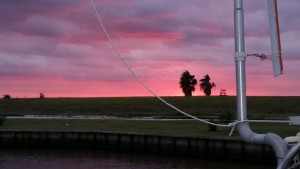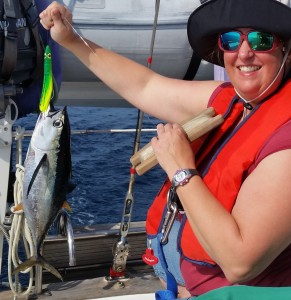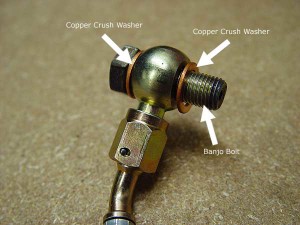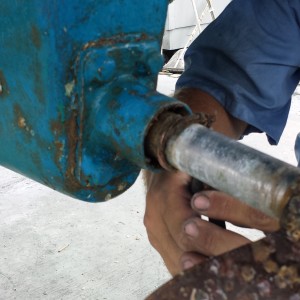Preparation, planning, and perfect timing are all that it takes for a beautiful five and a half day sail across the Gulf of Mexico to Florida from Texas. The wind, blowing nicely from the north at 12 to 15 knots, provides a beam reach that is the envy of all who have gone before. Calm seas with outstretched wave height of two to three feet seem to mock the stories of the Gulf’s treacheries. Averaging 7 to 8 knots puts us there in less time than we imagined. Having a beautiful chef on board and catching yellow fin tuna along the way round out the trip to make it the absolute best experience a sailor could want…
Well, that was how it was supposed to go.

We set out from Seabrook, Texas on October 27th with the wishful vision of a story like the one above. Hurricane Patricia had just crossed Mexico from the Pacific a few days before. We had been waiting more than a week for a weather window suitable for the trip. It looked like a low pressure system was following the hurricane which could provide the North winds we wanted so we threw off the lines and away we went.
The weather did seem to be cooperating. It was a pleasant 75 degrees at 9am and we were on our way. Next stop was to be Regatta Point Marina in Palmetto, Florida. The first leg from Seabrook to the Galveston Jetties brought the first setback. The bilge pump was running more than usual. A quick investigation revealed a plastic water line fitting to the water heater had burst dumping 45 gallons of our fresh drinking water into the bilge and straight overboard. In hind sight, we were lucky this happened in time for us to stop at the Galveston Yacht Basin for a small repair and replacement water rather than happening later with nowhere to get more water.
Only a couple hours over schedule, we left Galveston Yacht Basin about 3pm. Here is our philosophy on a “schedule” for sailing: Time frames are more like guidelines and possibilities rather than set in stone. So many things change. Adhering to a tight schedule ends up just causing frustration. We estimated six or seven days for this trip but allowed ourselves a three week window. Such is the life of a sailor, slow and easy (I use the term “easy” loosely.) Once clear of the Galveston Jetties, the rest of the first day brought little wind so we motor sailed at about 6 knots.
As part of our preparation for this trip, we purchased a Delorme inReach Explorer as an emergency communication device and a way to let family and friends follow our journey. This device allows you to send and receive texts up to 160 characters long. It tracks your progress and posts it on a map online which can be viewed by those who have the correct url. We have it on our site here: Our Location. Having very little time to learn this device before the trip, I made a mistake soon after leaving our marina while looking through the settings. There is a setting called “Extended Tracking.” That sounded like what we wanted so I pushed it. About 8 hours later, we started receiving calls from friends wanting to know when we were going to leave. As luck would have it, we were still in cell phone range due to our little plumbing delay. Well, evidently, the “Extended Tracking” shuts down the automatic map updates and only tracks locally on the device itself. So, it looked like we were still in Seabrook. Once that was changed back, another friend advised us that the track was still not showing. We made a call to Delorme for technical help. The technician was very nice and explained that our friends had to click a little white dot on the map share page to see the track. I am not sure why this is not more obvious on the page but that is what he said and we passed it on.
After our trip, I learned more…in addition to tracking, the InReach allows you to create up to three preset messages which you can send to as many email address and/or mobile phone numbers as you want. You then can send any of these preset messages during your trip whenever you want and they do not count against your allotted number of messages. I set this up with several people on the list. What was not made clear in the instructions is the fact that the preset message contains a link to your map share page but does not allow viewing of your track. It only shows you as a dot at your current location. To view the track, the recipient must first get off of that page and go to a different map share page, the original one that you share with everyone. This was a little confusing for some of our family, especially the less tech savvy ones like me so some of our friends and family only got to see where we were when we decided to send a preset message. In our case, we sent one of these messages about every 12 hours.
Another area that was different from what we expected was receiving texts. In order to receive a text, you must first initiate the conversation by sending a text to someone from the device itself. They cannot text you first. You cannot give a number for people to text; they must click on the link in the text you send them to respond.
Overall, the Delorme InReach is a very neat device that is similar to the Spot but with a few extra features. I can highly recommend spending the money. Their monthly service plans are affordable and customizable. They even have a plan that lets you start and stop the service without penalty. It was a good addition to our cruising experience.
Back to the Trip
We had been talking off and on for several days leading up to our departure about how long the watches should be and decided it might be a good idea to break up the late night time into two hour increments but the evening and morning watches could be three hours. This was really Cheri’s idea and I think it worked out great. With only two people, this is what it looks like:
7:00 pm – 10:00 pm 1st Watch – Alan
10:00 pm – 12:00 am 2nd Watch – Cheri
12:00 am – 2:00 am 3rd Watch – Alan
2:00 am – 4:00 am 4th Watch – Cheri
4:00 am – 6:00 am 5th Watch – Alan
6:00 am – 9:00 am 6th Watch – Cheri
This way, the first watch gets to see the sun set and the last watch gets to see it rise which makes the three hours seem shorter. During the day we just took turns resting whenever needed and we switched who took the 1st watch each evening. It worked out very well for us.
Early the next morning at 4:30 the auto pilot stopped working with a clunking noise. It turned out to be the hydraulic ram arm had come loose at the rudder connection. Nothing was actually broken so it screwed back in place fairly easily. Repaired within an hour and both of us wide awake, the wind picked up to 15 knots so we shut the engine down with a beam run sail at about 5 knots.
Everything else went well the second day. We were able to sail without engine assistance until 7:30 that evening. With wind speeds down to 5 knots, the engine was started and we were back to motor sailing. About 15 minutes after starting the engine, the alternator belt started slipping and squealing. We have experienced trouble with alternator belts before so we have several spares but it was fixed by simply tightening it.
The third day started with the discovery that our battery chargers had been off. Not sure who, what, where, how, or why but I am pretty sure that Cheri had nothing to do with it (my way of saying it was my fault.) Anyway, had to start the diesel generator to charge the batteries for an hour. No biggie.
10:00am The Fourth Day FISH ON! Landed a 3lb bigeye tuna named Seaweed. The name came from Cheri thinking the line must be dragging seaweed. Turned out to be the tastiest seaweed I have ever had.

That evening while I was on watch, I began to smell diesel. Not a lot, just a faint smell. I checked the diesel cans tied to the rail, six 5gal jugs all intact with no leaks. As Cheri was waking up for a shift change, I went below and opened the engine room door. I call it an engine room even though it is really just a compartment…makes it sound more like a yacht. So, I open the engine room door and sure enough a small stream of diesel squirts out at me. As I frantically close the door while hollering for Cheri to shut down the engine, I am thinking to myself, how in the world am I going to fix this? We had some wind and I was tired so I decided to get some rest and figure it out tomorrow.
The Fifth Day
Up till this point I have not really mentioned the cuisine except the fresh fish. My hat is off to the planning and preparation that Cheri did in provisioning food for our trip. We had pasta. We had ham. We had homemade chicken noodle soup. We had chicken salad. We had fresh fruitcake, snacks, fruit, candy, breakfast bars, and…the list just goes on and on. It was a lot like being on a cruise ship, except without the ice sculptures and chocolate fountains. She pre-made most everything. The meals ended up being some of the highlights of the trip, right up there with the beautiful full moon on the first night.
Now about that fuel leak; I put it off until after one of those good meals I was telling you about. I found the leak but I first need to tell you the previous owner was a big fan of JB Weld. The leak was coming from a Banjo Bolt Connection. What the heck is a banjo bolt connection? I know, I had to look it up so I could tell you what to call it. These are fuel connections with fat hollow washers at the end of metal tubing through which a bolt with a hole in it goes through to tighten the whole thing into a fitting that passes fuel to the next destination.  The leak was one of these connections that had been repaired before with JB Weld instead of taken apart, cleaned and re-connected properly. Fortunately, the hardware underneath the JB Weld was in good condition and I was able to chisel off the JB Weld and re-install the connection. In all fairness, it might have been some of that magic putty or some other form of stop gap measure. I do not wish to give JB Weld a bad reputation. I have heard many people rave about how it fixed this or that when nothing else worked. The bottom line for this application is that it should not have been utilized without following up with a proper repair later. With the leak fixed we sopped up the diesel from the catch pan and cranked up the engine once again.
The leak was one of these connections that had been repaired before with JB Weld instead of taken apart, cleaned and re-connected properly. Fortunately, the hardware underneath the JB Weld was in good condition and I was able to chisel off the JB Weld and re-install the connection. In all fairness, it might have been some of that magic putty or some other form of stop gap measure. I do not wish to give JB Weld a bad reputation. I have heard many people rave about how it fixed this or that when nothing else worked. The bottom line for this application is that it should not have been utilized without following up with a proper repair later. With the leak fixed we sopped up the diesel from the catch pan and cranked up the engine once again.
November 1, 2015 The Sixth Day
01:30am Engine overheated. Water pump belt had broken. Just another day in paradise!
Always carry spare belts and impellers. Rebuilding an engine water pump under way in 8 foot seas was not on the list of what I had in mind when I envisioned this journey. However, stuff wears out and breaks whenever it wants to, not at my convenience. Once again, I have to give my lovely wife, Cheri, some credit for a good idea…she had spread out a yoga mat on our salon table to keep things from sliding off into the floor. This allowed me a place to perform the surgery needed on the water pump with only a few flying parts. This job went fairly well for the conditions.
Later in the afternoon we heaved to for transferring diesel to the fuel tank from the 5gal jugs. I figured about 100 miles to go would require less than 15 gallons so I transferred three of the six jugs of fuel. I also changed the bilge pump filter housing which kept getting clogged. I had a larger one so I just changed them out.
After about two hours of motoring, the alternator belt started squealing again. It had stretched beyond the point of tightening so it had to be replaced with a new belt. This required removing the water pump belt that I had just spent so much time getting to know earlier. I was just about at the breaking point here and a few choice words may have echoed my frustration across the water. But the story isn’t over yet.
After several days of nice sailing wind and weather, we found ourselves about 90 miles northwest of our destination with the wind and waves viciously coming directly from the direction we needed to go. I figured we would just power through and be in the marina the following morning.
This is where our log entries end. Not because we are finished, but because we are pretty exhausted and feel that we are almost there.
As I remember, we spent most of the night running at 3000 rpm. In the morning, I noticed a vibration in the floor of the aft cabin that was different than the normal drum of the propeller shaft turning below. Lifting the floor board revealed the propeller shaft turning fine but “floating” a little. Now it is confession time. During our last haul-out, just a month ago, one of the attendants called me to the back of the boat and showed me a thick wire wrapped around the propeller shaft just inside the housing, you know, just aft of the cutlass bearing? It appeared possible that it had been placed there on purpose but we decided that it also could have accidently been caught and wound itself around the shaft. I made an executive decision to have it removed without further investigation. After all, we were being hauled out to install a new thru-hull not to look at the propeller shaft.

Hind sight is a bitch some times and this was one of those times. As I stood over the wobbling shaft, these memories came crashing down like a ton of sh…uhm…bricks. Again I hollered to Cheri to shut it down. If my fear was correct, the cutlass bearing had worked its way out of the housing and the shaft was, somehow, staying partially centered. Once everything stopped, I moved it with my hand back and forth. It had a little play in it but not enough to be missing the cutlass bearing. Maybe it only came out a little and the zinc is holding it in place. The only way to be sure was to visualize it. The waves had calmed down to maybe 5 or 6 feet. The decision to go in the water was broached and discarded and thought about again and dismissed and finally determined to be the best course.
We heaved to and that is when we saw the jelly fish. Not just one or two and not the small fist size ones from the marina either. There were schools of big bowling ball size jelly fish flowing by with the current, which seemed awfully swift for my swimming abilities. I thought to myself, “No way am I going in the water with those things.” But what could I do? “I know, I will put my snorkel mask on and lay on the aft swim platform and just stick my head below the surface and I should be able to see the propeller shaft.”
Yep! That is what we did. I tied a rope around myself, put on a life vest, handed the running end to Cheri and said, “Here, hold on to this, babe.” I have seen that look on her face before but never when I was so sober. In all honesty, neither one of us took any of this lightly. After thinking and talking everything through, I came to the conclusion it was the only thing we could do and she came to the conclusion that she couldn’t talk me out of it with a better plan.
The first attempt at hanging over the side of the swim platform upside down put me in position only to see the rudder blocking my view of the propeller. I climbed back up, through and over and under the wires that hold the platform in place, turned around and lay back down to the other side. I am sure it looked quite amusing but I was not in the mood for joking and Cheri kept a straight face. As I ducked my head in the water, I saw the propeller turn a little and stop just in the right spot to hide the shaft behind it. I tried to stay underwater long enough for it to turn again but couldn’t hold my breath. I came up for air and tried again…propeller still blocking. I had not seen any more jelly fish come by so I went in the water and pulled myself close enough to see the cutlass bearing indeed about half way out of the housing. The boat lifted with a wave and came down bumping my head just enough to let me know it was time to go.
Back in the cockpit wringing out the water, we weighed our options.
- Sail – indirectly into the wind and waves, 90 miles which could take another two days or so.
- Call a tow – Only as a last resort with every other option exhausted.
- Motor slowly and monitor the shaft vibration – one more day and we should be there.
We chose number 3.
Now you might think we just casually motored the rest of the way and everything was hunky dori. And you would be right, almost.
One final slight miscalculation on my part and the story ends with us safe in harbor…
The Fuel
In all the commotion and confusion, I forgot to recalculate the fuel consumption. You see, we usually burn a little over ¾ gallon an hour. Remember when we refueled and the sea was a little rough and I decided that three of the jugs should be plenty for 12 more hours? Well, somewhere around 26 hours later, we were just about to cross the Tampa Bay Ship Channel when the engine started sputtering again. It took only a few minutes for us to realize the mistake. After a quick fuel transfer of another five gallons we were back on our way.
The Tampa Bay entrance is littered with crab pots. I am glad we got there during daylight. With Cheri on deck spotting, we successfully navigated the crab pot mine field and dropped the sails at the mouth of the Manatee River. Navigating the river was pretty straight forward but we turned into the marina one entrance too soon. As I started to turn around the engine acted like it was going to die again. It would not idle so I had to either be in forward at a high rpm or reverse at a high rpm. We made it back out and into the correct place and as I turned into the slip, the engine died. There must have been 20 people at the dock waiting for us. They all grabbed lines and guided us the rest of the way into the slip. As we tied up and stepped off the boat, several people showed up with cold beers in hand and free directions to the showers.
Regatta Point Marina: Fellow cruisers, weekenders, and liveaboards just waiting to hear a tale.
And this is just our first stop 🙂

LMAO and quivering in my boots at the same time…. more and more reasons for the admiral to learn to single hand while the captain goes off on these risky ventures. (This is what I’m telling myself I need to do) Wow, such great stories to talk about later over a glass of wine. Old Boats, who’s have ’em? All of us that’s who! You guys rock on.
Hey Cheri and Alan! Delighted to make your acquaintance and follow along on your journey! As winter approaches up north, the Florida climate is starting to look pretty appealing to me right now!
Hello Claire,
Welcome abaord!
Yes, Florida has very nice weather and friendly people to go with it 🙂
Come on down!